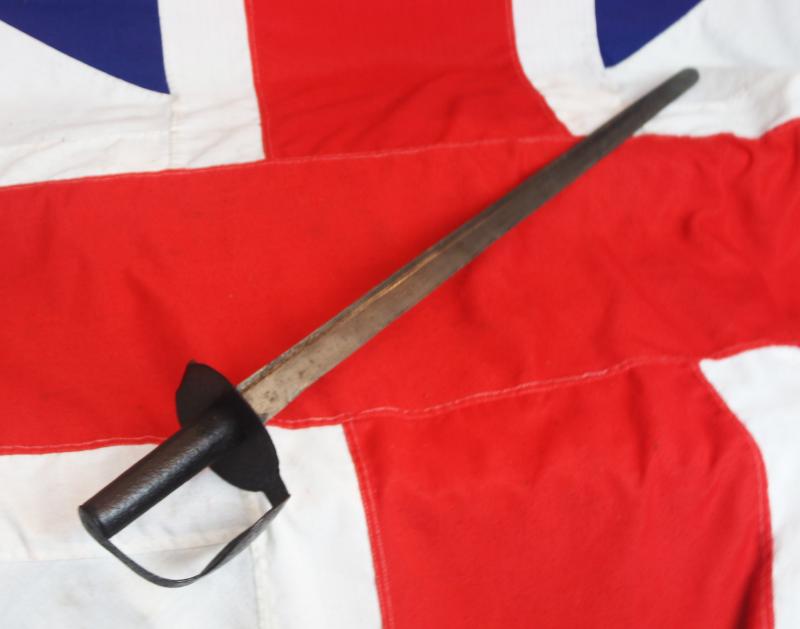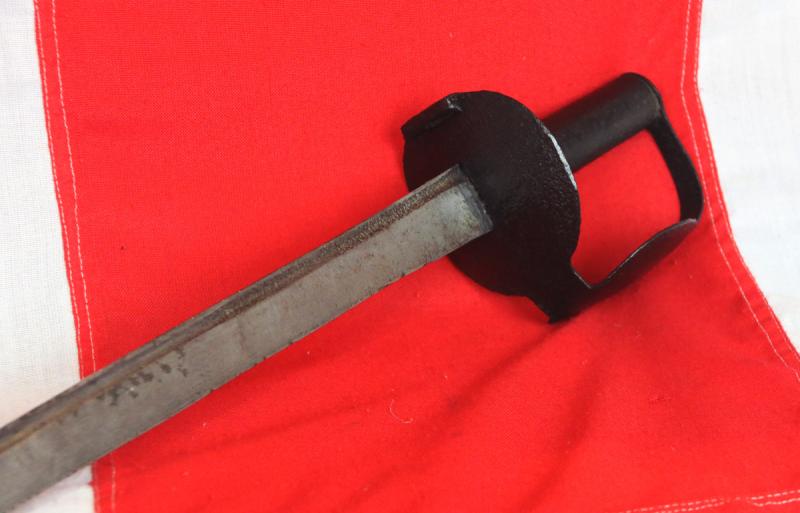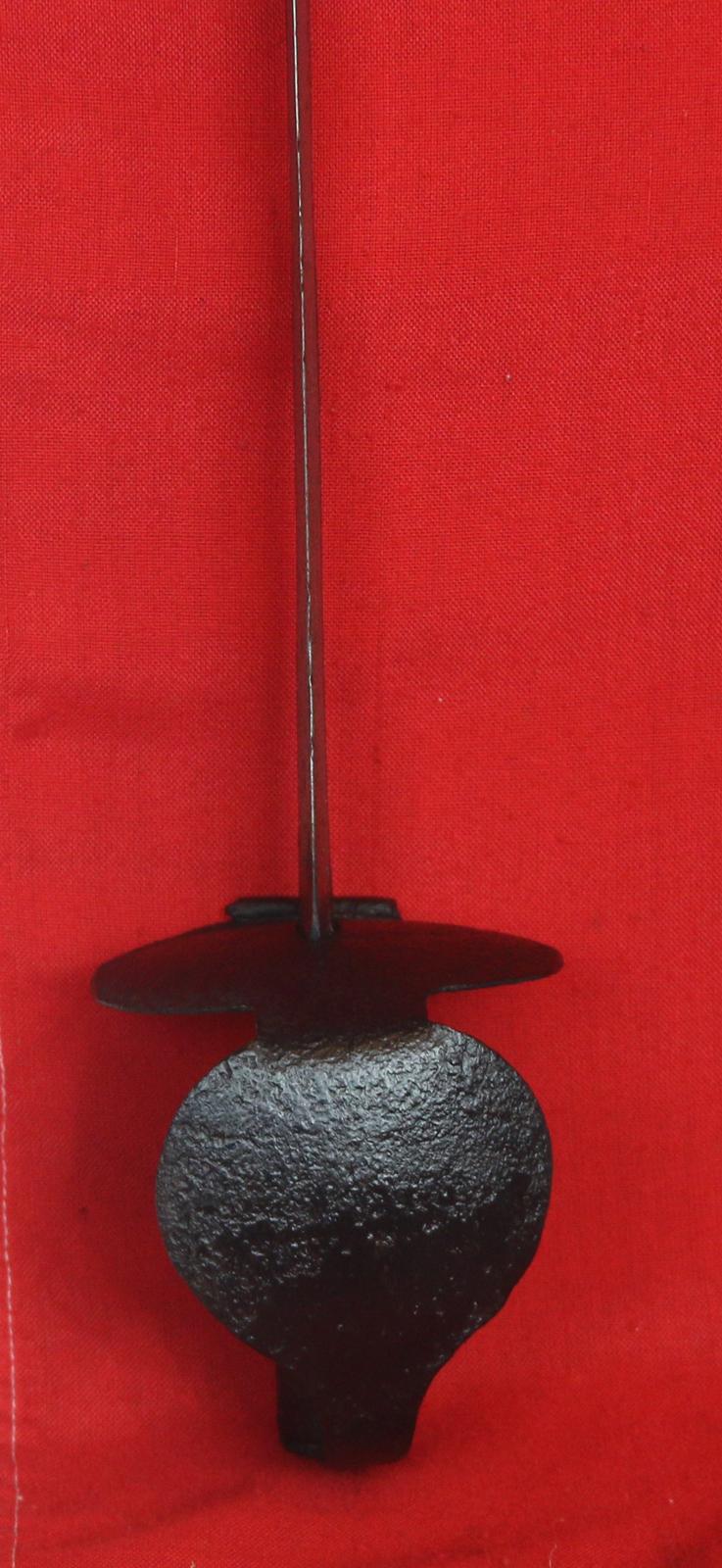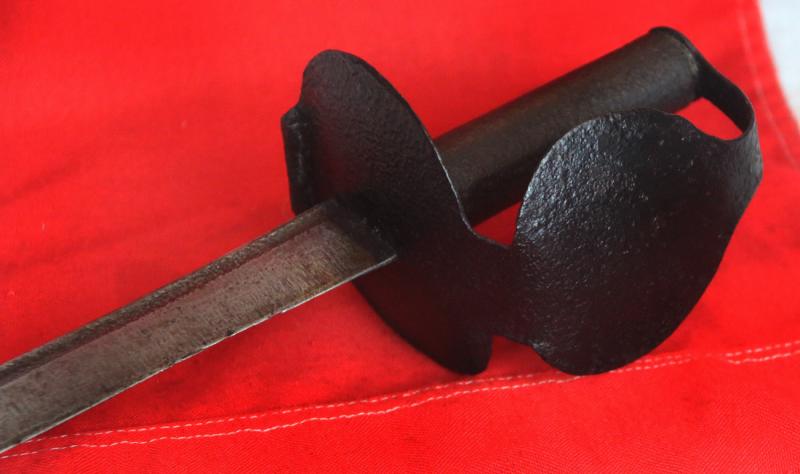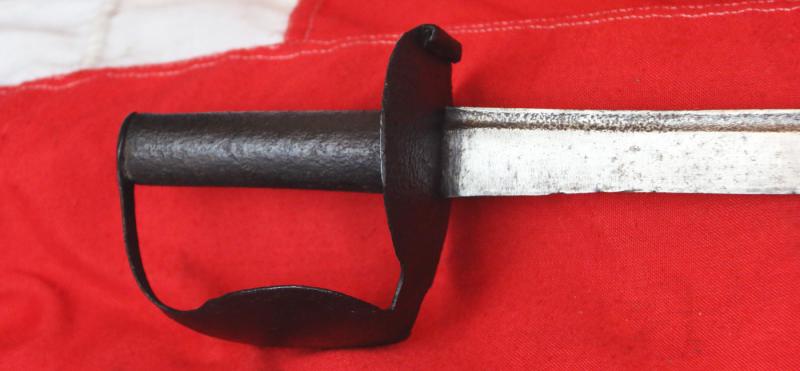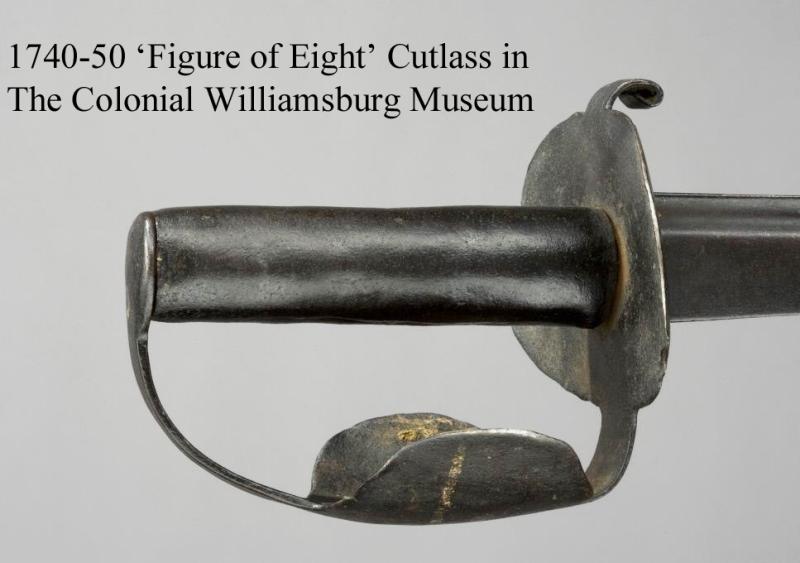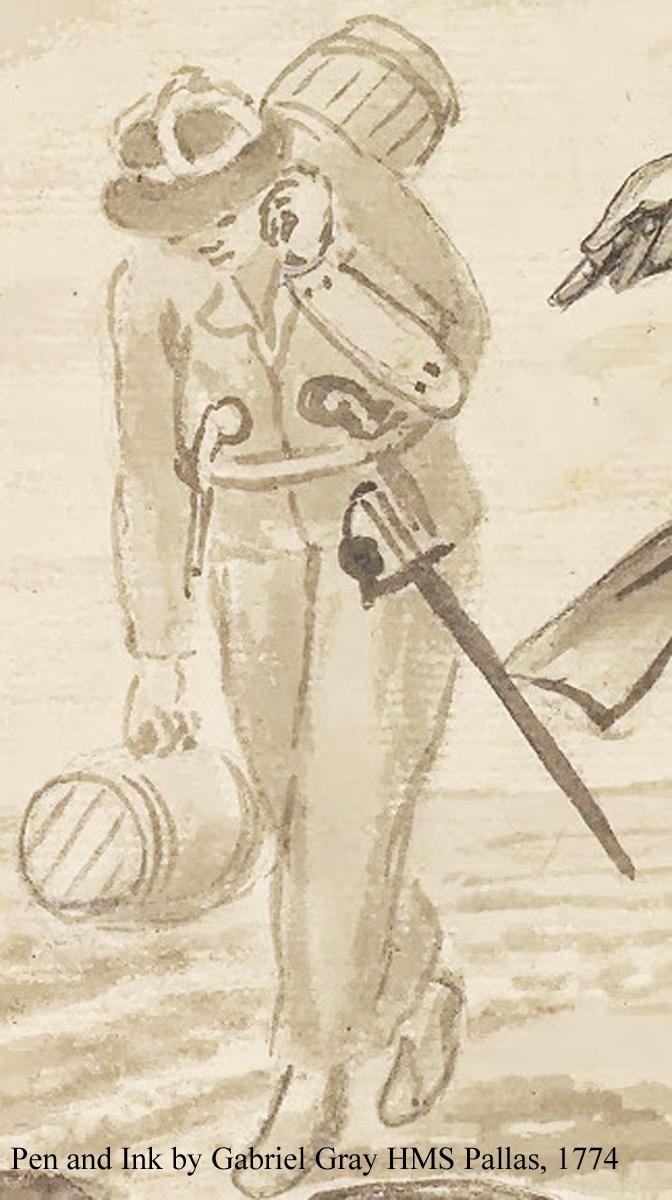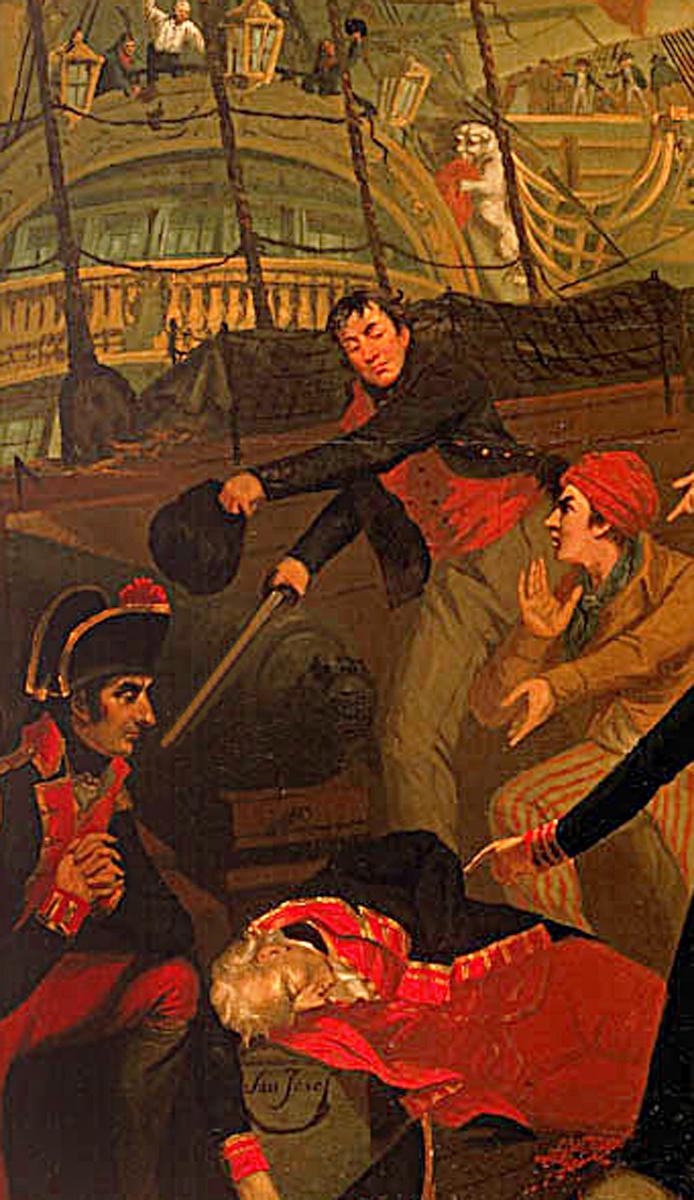A Most Rare 18th Century Royal Navy Combat Cutlass, with Iron Double Disc {Figure of Eight} Hilt and Tubular Steel Grip. With Straight Back-Sword Blade With Single Fuller. Designed by Thomas Hollier in the Early 18th Century
The form of the first, official issue, original Royal Naval combat cutlass used at sea, on boarding parties and shore patrols in the 18th century, then in the early 19th up to and including Trafalgar in 1805. Interestingly it is also known the 1st American Naval pattern cutlass, as it was adopted from us, and often cutlasses that were captured in naval engagements in the Revolutionary War.
Usually, of all the cutlasses issued to the Royal Navy in the 19th century, the often most desirable by collectors is the 1804 pattern, that has a ribbed cast iron grip, as opposed to the earlier wood grip, wrapped in a rolled iron sheet. The 1804 pattern is a scarce cutlass, rarely found, but most significantly, it was this type, the one that was issued long before the fleet went to face the Spanish and French fleet at Trafalgar, {that were roundly defeated by Admiral Lord Nelson} that is the rarest and most valued of all.
However, ironically, the rarest of all the regulation issued cutlasses, is the one that is the least well known, because of its scarcity, it is this, the 18th-century version, which was the original and first issued cutlass that saw service in the Royal Navy. From the 7 Years War period {1756-1763} fought in America, that was before the American Revolution fought from 1776, then, through to the Anglo-French war such as at the battle of ‘ The Glorious 1st of June’, the Battle of The Nile, and at Trafalgar.
The Battle of the Glorious First of June in 1794 was the first naval conflict between the British and the French during the French Revolutionary Wars, 34 British battle ships against 26 French. All along the line, the fighting was intense, and by the time the firing died away, 11 British and 12 French ships were more or less dismasted, 7000 were killed, wounded and captured on the French side, and 1000 killed or wounded from the British fleet.
Six French ships were captured and another, the Vengeur, sunk, while the damaged remainder of the French fleet made off in considerable confusion. After five days of strenuous chase and a hard-fought battle, the British were too exhausted to mount a pursuit.
Tactically, the British had won the day, and the news of victory was greeted with wild enthusiasm in Britain, but the grain convoy from America had escaped intact.
The Battle of the Nile (also known as the Battle of Aboukir Bay; French: Bataille d'Aboukir) was a major naval battle fought between the British Royal Navy and the Navy of the French Republic at Aboukir Bay on the Mediterranean coast off the Nile Delta of Egypt between 1–3 August 1798. The battle was the climax of a naval campaign that had raged across the Mediterranean during the previous three months, as a large French convoy sailed from Toulon to Alexandria carrying an expeditionary force under General Napoleon Bonaparte. The British fleet was led in the battle by Rear-Admiral Sir Horatio Nelson; they decisively defeated the French under Vice-Admiral François-Paul Brueys d'Aigalliers, destroying the best of the French navy, which was weakened for the rest of the Napoleonic Wars. The British fleet arrived off Egypt on 1 August and discovered Brueys's dispositions, and Nelson ordered an immediate attack. His ships advanced on the French line and split into two divisions as they approached. One cut across the head of the line and passed between the anchored French and the shore, while the other engaged the seaward side of the French fleet. Trapped in a crossfire, the leading French warships were battered into surrender during a fierce three-hour battle, although the centre of the line held out for a while until more British ships were able to join the attack. At 22:00, the French flagship Orient exploded which prompted the rear division of the French fleet to attempt to break out of the bay. With Brueys dead and his vanguard and centre defeated, only two ships of the line and two frigates escaped from a total of 17 ships engaged.
The battle reversed the strategic situation between the two nations' forces in the Mediterranean and entrenched the Royal Navy in the dominant position that it retained for the rest of the Napoleonic Wars. It also encouraged other European countries to turn against France, and was a factor in the outbreak of the War of the Second Coalition. Bonaparte's army was trapped in Egypt, and Royal Navy dominance off the Syrian coast contributed significantly to the French defeat at the siege of Acre in 1799 which preceded Bonaparte's abandonment of Egypt and return to Europe. Nelson was wounded in the battle, and he was proclaimed a hero across Europe and was subsequently made Baron Nelson—although he was privately dissatisfied with his rewards. His captains were also highly praised and went on to form the nucleus of the legendary Nelson's Band of Brothers.
This 18th century regulation cutlass was used by ships at all of the battles as previously described, and many more, and many were used by the fleet under Nelson’s command at Trafalgar. This is one of those very rarest cutlasses, it is the rarest of the rare, as so few survived today, as they were significantly replaced by the 1804 pattern with the cast iron ribbed grip.
Original accounts of naval cutlass use in the Americas in the 18th century.
When a press gang boarded the Boston merchantman Hawke in 1741, a young Ashley Bowen had to distract the Royal Navy midshipman who 'examined our small arms and missing some of our cutlass and pistols out of their places...began to examine our bulkheads' in search of the shipmates that presumably held those arms to resist.'
John Nicol, serving during the Revolutionary War, wrote: 'I was one of the boarders. We were all armed, when required, with a pike to defend our own vessel should the enemy attempt to board; a tomahawk, cutlass and brace of pistols to use in boarding them. I never had occasion to try their use on board the Proteus, as the privateers used to strike after a broadside or two.'
John Iver, 'mate of an East India Ship,' in a letter written to his wife and published in Jackson's Oxford Journal, resorted to an extreme measure to carry his cutlass when the ship caught fire and Lascar sailors tried to escape on the only boat available. Ordered by the captain to; 'save him and the rest of the Europeans,' Iver wrote 'I took a cutlass in my mouth, and directly jumped overboard.
Code: 25364


